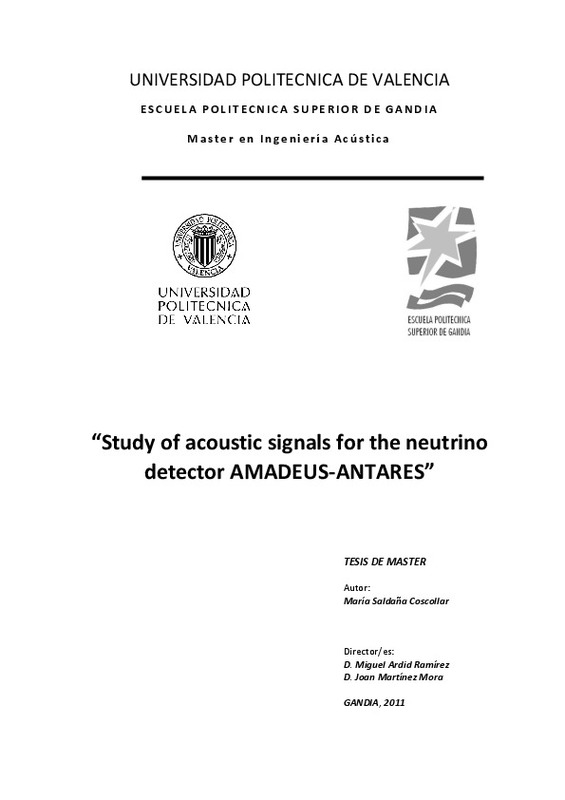JavaScript is disabled for your browser. Some features of this site may not work without it.
Buscar en RiuNet
Listar
Mi cuenta
Estadísticas
Ayuda RiuNet
Admin. UPV
Study of acoustic signals for the neutrino detector AMADEUS-ANTARES
Mostrar el registro sencillo del ítem
Ficheros en el ítem
| dc.contributor.advisor | Ardid Ramírez, Miguel
|
es_ES |
| dc.contributor.author | Saldaña Coscollar, María
|
es_ES |
| dc.date.accessioned | 2011-12-23T12:01:21Z | |
| dc.date.available | 2011-12-23T12:01:21Z | |
| dc.date.created | 2011-09-15 | |
| dc.date.issued | 2011-12-23 | |
| dc.identifier.uri | http://hdl.handle.net/10251/14132 | |
| dc.description.abstract | Este proyecto estudia aspectos acústicos pertenecientes al proyecto europeo ANTARES. Por una parte, se centra en el análisis de las señales acústicas recibidas en el sistema de posicionamiento AMADEUS-ANTARES. El programa analiza las señales captadas por los sensores, las analiza de manera individual, aplicando una serie de filtros y transformaciones, extrayendo, la frecuencia, fase y amplitud propia de la señal. A continuación, fija el tiempo de subida y de bajada apropiado para la señal, con el que se obtiene su duración. La aplicación es diseñada con objetivo de automatizar la detección y análisis de las señales recibidas del sistema, consiguiendo mayor precisión en la reconstrucción del posicionamiento de fuentes. Por otra parte, se lleva a cabo el diseño y calibración de un array lineal de ocho hidrófonos que genera, de manera artificial, el pulso bipolar de energía ultra alta generado por el neutrino en su interacción con el agua. El objetivo del array es transmitir al detector acústico de ANTARES la señal bipolar con similares características en amplitud, forma y directividad a la señal acústica creada por el neutrino en el agua. La calibración es desarrollada combinando métodos de procesado de señal junto con medidas experimentales. El array de hidrófonos es posicionado coherentemente en fase, a distancias conocidas. Aplicado el "delay" correspondiente, la señal acústica bipolar es obtenida con mayor amplitud y directividad. La simulación del array acústico es estudiada con el objetivo de conocer la longitud y diseño idóneo para la correcta transmisión de la señal bipolar hasta el detector. This academic work study acoustic aspects of the ANTARES detector European project. For the one hand, the signal analysis processing for the acoustic signals received by the AMADEUS-ANTARES. The software developed analyses the received signal of each sensor and analyses them individually, applying specific filters and transformations in the frequency and time domain, getting the phase, frequency and amplitude belonged to the signal. For the next step, it fixes the Rise Time and Fall Time appropriated for the signal what with is obtained the signal duration. The application is developed for automating the detection and analysis of the received signals from the positioning system, achieving higher accuracy. For the other hand, an eight lineal array hydrophone is designed and calibrated for generate the artificial Ultra High Energy (UHE) neutrino-induced pulses. The array goal is the transmission of the bipolar acoustic signal pulse mimicking (simulating) the neutrino acoustic signal in terms of amplitude, shape and directivity to the ANTARES detector. The calibration is developed using signal processing methods within experimental measures. The array hydrophone is located coherently in phase with known distances. Hence, the delay between them is applied to get a higher amplitude and directivity acoustic bipolar pulse. The acoustic array simulation is studied in order to know the length and design for the proper bipolar signal transmission to the detector. | es_ES |
| dc.format.extent | 81 | es_ES |
| dc.language | Inglés | es_ES |
| dc.publisher | Universitat Politècnica de València | es_ES |
| dc.rights | Reconocimiento - No comercial - Compartir igual (by-nc-sa) | es_ES |
| dc.subject | Neutrinos | es_ES |
| dc.subject | Analisis de señales acusticas | es_ES |
| dc.subject | Detección acústica | es_ES |
| dc.subject | Array de hidrófonos | es_ES |
| dc.subject | Uhe neutrinos | es_ES |
| dc.subject | Acoustic signal analysis | es_ES |
| dc.subject | Acoustic detection | es_ES |
| dc.subject | Hydrophone array | es_ES |
| dc.subject.other | Máster Universitario en Ingeniería Acústica-Màster Universitari en Enginyeria Acústica | es_ES |
| dc.title | Study of acoustic signals for the neutrino detector AMADEUS-ANTARES | es_ES |
| dc.type | Tesis de máster | es_ES |
| dc.rights.accessRights | Abierto | es_ES |
| dc.contributor.affiliation | Universitat Politècnica de València. Departamento de Física Aplicada - Departament de Física Aplicada | es_ES |
| dc.contributor.affiliation | Universitat Politècnica de València. Instituto de Investigación para la Gestión Integrada de Zonas Costeras - Institut d'Investigació per a la Gestió Integrada de Zones Costaneres | es_ES |
| dc.contributor.affiliation | Universitat Politècnica de València. Área de Posgrado - Àrea de Postgrau | es_ES |
| dc.contributor.affiliation | Universitat Politècnica de València. Escuela Técnica Superior de Ingeniería del Diseño - Escola Tècnica Superior d'Enginyeria del Disseny | es_ES |
| dc.description.bibliographicCitation | Saldaña Coscollar, M. (2011). Study of acoustic signals for the neutrino detector AMADEUS-ANTARES. Universitat Politècnica de València. http://hdl.handle.net/10251/14132 | es_ES |
| dc.description.accrualMethod | Archivo delegado | es_ES |
Este ítem aparece en la(s) siguiente(s) colección(ones)
-
EPSG - Trabajos académicos [5004]
Escuela Politécnica Superior de Gandia






